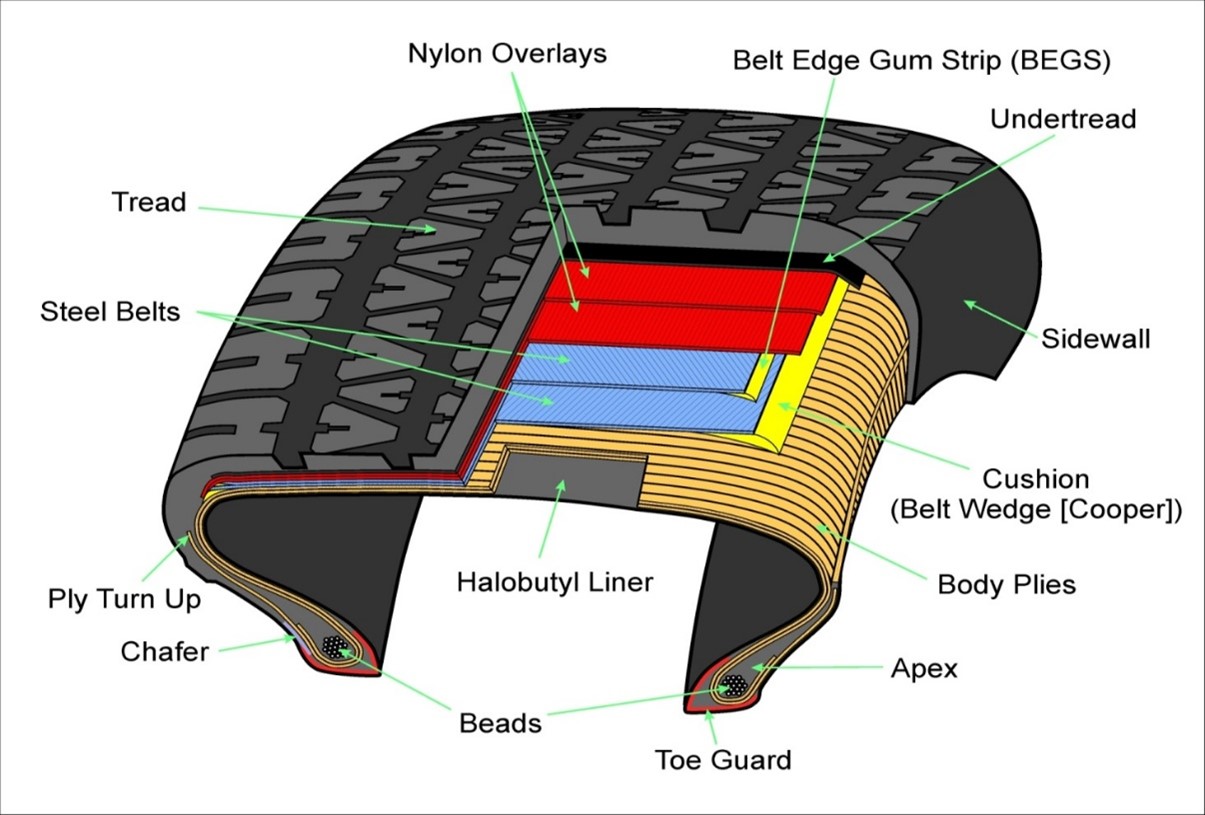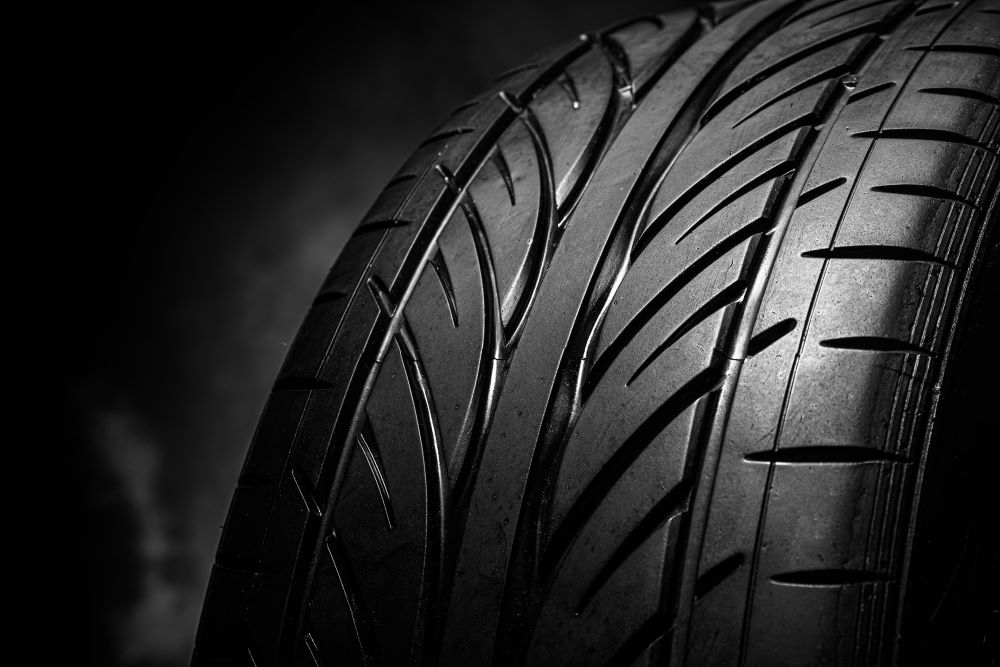When we set out on the road, tires silently bear the burden of our travels, connecting passenger vehicles to pavement through four small patches of rubber. Overlooked workhorses, tires have complex engineering that enables nuanced performance. Should failure leave us stranded, comprehending how and why becomes vital, though we rarely ponder tires’ intricacies until misfortune strikes.
Tire failure analysis is like a detective story played out on the rubbery canvas of a tire, where clues abound revealing the cause of failure. Examining details such as tread wear patterns, external damage, and internal ruptures provides evidence that whispers the tales of stress, misuse, or hidden defects that led to the tire’s demise. By carefully dissecting these clues, the analysis determines the root cause – the “whodunit” – behind the tire failure.
Cast of Characters
Before unraveling the plot, let’s get acquainted with the main characters:
- Tread: Crown of the tire that contacts the roadway. The tread pattern and compound are responsible for tire traction and grip.
- Cap ply: Fabric belts wound circumferentially embedded within the tire, providing increased durability and high-speed capability.
- Belt package: Steel belts within the tire, providing strength, rigidity, and stability.
- Sidewall: The flexible rubber that connects the tread to the bead area of the tire absorbs bumps and provides lateral stability during cornering maneuvers.
- Bead: The area of the tire that interacts with the wheel, anchoring the tire to the rim.
Suspects
Now, the suspects in the tire failure drama:
- Overloading: When your tires are carrying more weight than they can safely handle, leading to increased tread wear, sidewall bulges, and heat generation.
- Underinflation: Low tire pressure increases heat generation and tread deformation, accelerating shoulder wear. In extreme cases, the sidewall can be abraded due to contacting the roadway.
- High speeds: Prolonged driving at high speeds can cause excessive heat buildup, which may lead to tread and belt separation in the tires.
- Road hazards: Sharp objects, potholes, and curbs can puncture the tread, damage the sidewall, or sever the belts.
- Manufacturing defects: Faulty materials, improper construction, or inadequate bonding can lead to premature tire failure.
- Age and deterioration: Rubber naturally degrades over time losing its elasticity and increasing vulnerability to cracks and blowouts.
Investigation
A thorough tire examination requires the expertise of an experienced tire forensic analyst who can identify subtle clues missed by others. Unlike an accident reconstructionist lacking extensive tire knowledge, a tire expert with over 25 years of experience will conduct a meticulous visual and tactile inspection. This reveals intricate details within the tire that provide clues into its failure, such as internal pattern marks, mounting damage, belt defects, cracks, separations, and heat damage along the tread, belts, and sidewall. Scrutinizing these failed internal surfaces provides insights an untrained eye will overlook.
Advanced Techniques
Beyond visual analysis, the following sophisticated tools aid in the investigation:
- X-ray and Shearography testing: These tools reveal internal damage like hidden punctures, manufacturing defects, and belt separations.
- Chemical analysis: Rubber compounding to identify age-related deterioration.
- Finite element analysis: Computer simulations replicate real-world strains on the tire, highlighting potential failure.
Case Studies of a Few of the “Suspects”
Tires overloaded due to improper inflation by the shop:
We were hired to investigate a string of front tire failures in the fleet vehicles of a well-known commercial truck dealer, whose name we are not disclosing. The only available tire from these failures showed clear signs of operation while overloaded or underinflated. Interviews with the operations manager and maintenance manager during our inspection revealed the likely causes behind the repeated tire failures.
The operations manager revealed that the tire failures started about two years ago, coinciding with the release of the new version of the tractor truck model.
The maintenance manager disclosed that the front tire inflation pressure was set and maintained at 110 pounds per square inch (psi), despite the vehicle’s tire placard specifying 120 psi. When asked about this discrepancy, the manager responded that the front tires had “always” been filled to 110 psi, though no rationale was provided for ignoring the manufacturer’s recommendation.
High speed operation – Tires operated over their rated speed capacity:
A commercial wrecker, a large truck with 4 axles used to tow fully loaded tractor trailers, experienced a front tire failure. Inspection of the failed tire revealed it failed from excessive circumferential forces; the tire had been driven faster than its certified speed rating allowed.
The vehicle engine control module of the truck was downloaded and showed a recorded speed of 80 mph. The owner and driver of the wrecker at the time of the failure was interviewed. When asked about the speed he was driving, the owner stated that as an emergency vehicle, he always drives 80 mph (max speed of the truck).
The front tires on the commercial wrecker were rated for 68 mph. This was below the speed the truck was being driven. The truck’s speed governor was improperly set, allowing the vehicle to exceed the tires’ speed rating for extended periods. When a tire is operated significantly above its speed rating, the excessive heat and forces can cause it to come apart. In the United States, all tires with a DOT code molded into the sidewall have a designated maximum speed rating that should not be exceeded.
Defects within the tire:
The rear tire on the passenger car failed due to a separation between the tread and outer steel belt. The tire was relatively new, having been installed a year ago and driven approximately 32,000 miles. There were no signs of misuse or abuse upon inspection. An open splice in the Halobutyl rubber inner liner, which sits next to the tire’s air chamber, was identified as a manufacturing defect that caused premature failure. The inner liner functions as a built-in inner tube inside the tire. (See tire cutaway diagram below).

An open splice in the liner exposes the internal tire components to pressurized oxygen, accelerating degradation at high-stress areas like the belt edges. Oxygen causes the rubber around these stressed belt edges to degrade losing elasticity and strength like an old rubber band. Eventually, internal cracks form and grow, leading to tread and belt separations.
Determining Cause
The tire expert gathers and analyzes evidence to determine the cause of the failure, providing crucial knowledge for manufacturers to improve tire design and quality control, for motorists to understand proper tire care and maintenance, for safety investigators to prevent future accidents, and for juries to determine if tire failure contributed to a collision.
Forensic tire failure analysis extends beyond simply identifying the cause. It provides valuable insights into the following:
- Tire performance parameters
- Improved tire design
- Public safety education
Conclusion
Tire failure is a complex issue, but solutions can be found through meticulous analysis. By delving into the fascinating world of expert tire failure analysis, we can unravel the mysteries of these seemingly simple components. The next time you glance at your tires, remember, they are more than rubber and steel donuts – they contain intricate stories waiting to be told for the sake of our safety on the road.










